Posts Tagged ‘Caddis’
{{start}}
The caddisflies are an order, Trichoptera, of insects with approximately 7,000 described species. Also called sedge-flies or rail-flies, they are small moth-like insects having two pairs of hairy membranous wings. They are closely related to Lepidoptera (moths and butterflies) which have scales on their wings, and the two orders together form the superorder Amphiesmenoptera.
Caddisflies have aquatic larvae and are found in a wide variety of habitats such as streams, rivers, lakes, ponds, spring seeps and temporary waters (vernal pools). The larvae of many species use silk to make protective cases of gravel, sand, twigs or other debris.
{{end}}
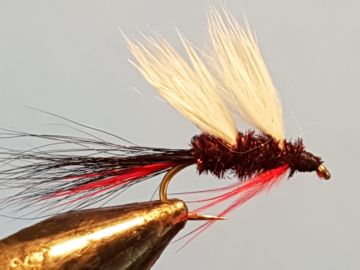
{{+1}}Claret caddis{{-1}}
{{start}}
Any time there are caddis on the wing this fly is worth a swim in the middle position of a team of three loch flies. One of the most important things to remember when tying this fly is not to overdress it ... make sure you can see a gap between the two wings even when the rabbit fur is dry and fluffed out.{{end}}
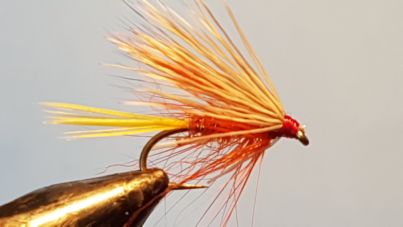
{{+1}}Half-dunk{{-1}}
{{start}}
This is one of the flies that I have tied for an impending trip to N.Ireland to fish in the 2018 Commonwealth Fly Fishing Championships. My research shows that there can be Autumn hatches of caddis and occasionally olives and midge. Those sort of hatches often occur in relatively shallow water and often the fish are taking the emergers just as they are trying to break away from the surface.
This is what I came up with.
It's the wing half of a elk hair caddis or a Sedgehog type fly (hence the "Half") married into the body of a Dunkeld (giving me the "dunk")... anyway it deserved a name.

Materials
| Hook | Thread | Tail | Rib | Body | Hackle | Wing |
|---|---|---|---|---|---|---|
| Tiemco 3769 #10) | Danvilles 70 denier in red | Yellow hackle fibres | Uni soft wire #33 Sm in gold | 50/50 Hends spectra #35 & orange seals fur | Orange | Natural deer hair |
{{end}}
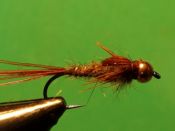
{{+1}}TBH “inch” nymph{{-1}}
{{start}}
This fly has it's origins based on my non bead-head inch nymph fly that I started tying over 20 years ago. For about 10 years now I have been tying this bead-head version in in black, dark olive, Adams colours, claret and brown. It's a great buggy looking fly and one of the on-going inclusions in my nymph fly box.{{end}}
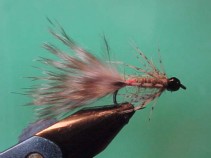
{{+1}}TBH hot butt caddis bugger{{-1}}
{{start}}
If your fishing in water with reasonably numbers of caddis your going to want to give this 3 cm bugger a swim. Caddis represent up to 70% of a trout's diet and whilst this fly is bigger than any caddis nymph I have seen trout love it. It is also a must tie on fly for discoloured water. You can fish it as a nymph but my preference is to fish it across, down and on the swing.{{end}}
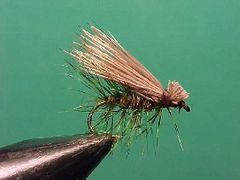
{{+1}}Elk hair caddis{{-1}}
{{start}}
When a caddis fly hatches it rises to the surface of the water, shedding its nest and shuck as it breaks through the surface tension of the water so as to reveal its wings. Caddis flies often use surface movement caused by wind and currents to assist in this process.{{end}}

{{+1}}Irresistible{{-1}}
{{start}}
The Adams Irresistible is just one representation of a Baetis Dun. It floats like a cork and what's more fish accept it as a variety of food items. In smaller sizes it is an excellent Baetis Dun imitation and an excellent fly in still water particularly when Snow Flake Caddis are about. In larger sizes it is an excellent fly for fast water or as a top fly in dry / nymph combination. Change the material colours to tie flies representing Baetis Duns in your target fishery. I carry Adams, black, brown and olive versions in a couple of sizes.{{end}}













